The Commission of Fine Arts and the Citizens Coinage Advisory Committee both recommended and rejected proposed designs for reverses of the America the Beautiful Quarters and companion five-ounce silver coins for 2017.
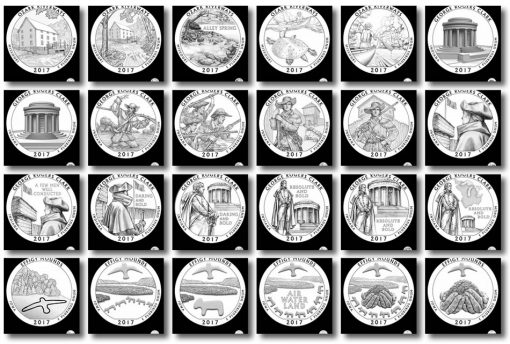
Neither the CFA nor the CCAC could stamp their approval on one the thirteen candidate designs for Effigy Mounds National Monument in Iowa, asking the U.S. Mint to submit more for consideration. The CCAC also couldn’t recommend any of the eight candidates presented for Ellis Island in New Jersey, requesting new or re-workings of the existing ones.
As for site designs the two panels did support, they were different from each other.
America the Beautiful Quarters commemorate national sites around the United States and its territories. The five up for honors in 2017 include:
- Iowa’s Effigy Mounds National Monument
- District of Columbia’s Frederick Douglass National Historic Site
- Missouri’s Ozark National Scenic Riverways
- New Jersey’s Ellis Island National Monument
- Indiana’s George Rogers Clark National Historical Park
Treasury Secretary Jack Lew has the responsibility of selecting final coin designs after receiving recommendations from the CCAC, CFA, United States Mint and national site liaisons.
To follow are images and descriptions of candidates for all five 2017 designs. The CFA and CCAC recommendations are provided under the site titles.
Effigy Mounds National Monument (Iowa)
CCAC Recommendations: Members did not select any of the designs, asking for more.
CFA Recommendations: The Commission members did not recommend any of the designs. They suggested exploration of a different framing of an aerial view, such as in alternatives #4, 4-A, and 4-B, to convey the larger grouping of mounds extending beyond the design’s edge. They also requested a more careful depiction of the mounds to convey their rounded shape.
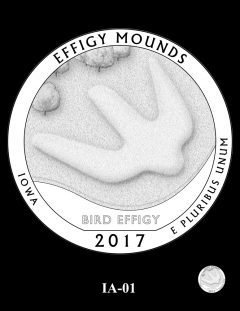 |
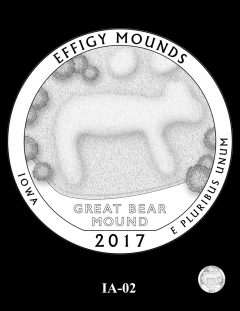 |
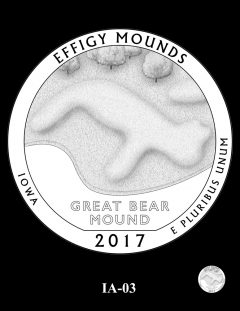 |
|
IA-01 depicts an aerial view of an effigy mound in the shape of a bird. This particular mound is part of the Marching Bear Group, a collection of mounds located in the South Unit of the monument.
IA-02 and IA-03 depict aerial views of Great Bear Mound, the monument’s largest mound.
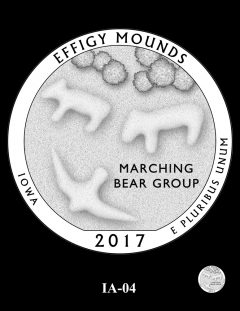 |
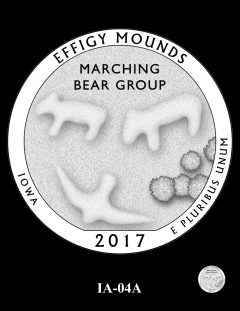 |
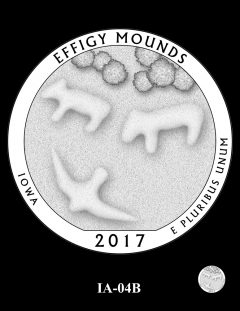 |
|
IA-04, IA-04A, and IA-04B depict variations on an aerial view of three effigy mounds that are part of the 15 mounds that comprise the Marching Bear Group.
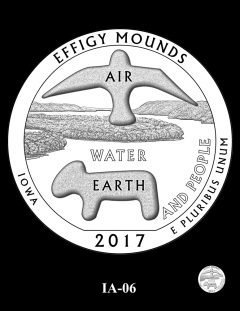
IA-06 features a bird effigy and a bear effigy against a depiction of the Mississippi River as seen from Fire Point Outlook. The inscriptions read "Air, Water, Earth, and People."
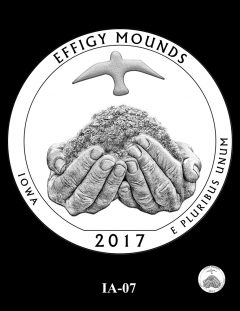 |
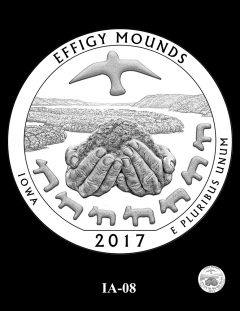 |
IA-07 and IA-08 depict hands holding earth with a bird effigy above. Design IA-08 also features the Mississippi River in the background and mounds from the Marching Bear Group.
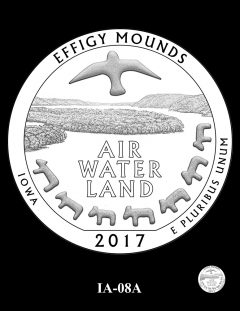 |
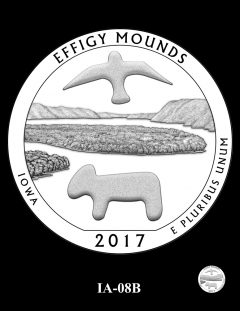 |
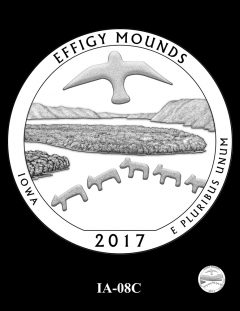 |
|
IA-08A, IA-08B, and IA-08C depict the Mississippi River in the background and a bird effigy at the top of the design. The lower halves of the designs feature variations of the bear effigies. Design IA-08-A also features the inscription "Air, Water, Land."
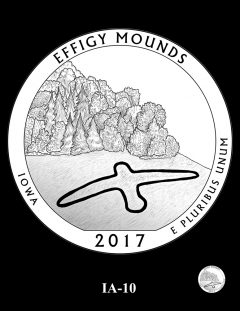
IA-10 depicts a bird effigy with a lush forest in the background.
Frederick Douglass National Historic Site (D.C.)
CCAC Recommendations: Members preferred design #1.
CFA Recommendations: The Commission members recommended design #4 for its strong depiction of both Douglass and his house, Cedar Hill. They commented that this dual emphasis maintains a focus on the historic site and also avoids the ambiguity of a double-headed coin in combination with the continuing obverse featuring the portrait of George Washington.
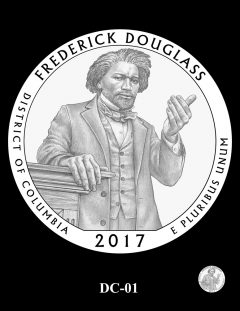 |
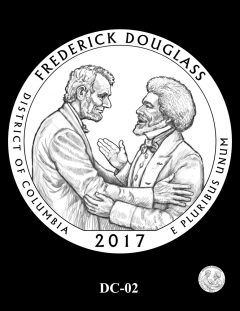 |
DC-01 (the CCAC choice) features Frederick Douglass giving a speech from a podium.
DC-02 depicts Frederick Douglass meeting with Abraham Lincoln. As one of the foremost abolitionists, Mr. Douglass met President Lincoln on three occasions in planning the role of African American men, both free and slaves, in the prosecution of the war. Douglas recruited African American men for several regiments, including the celebrated Massachusetts 54th. The President publicly acknowledged "Fred" as his friend on the occasion of his second inauguration celebration
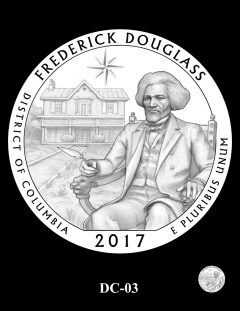 |
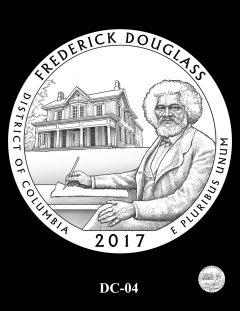 |
DC-03 depicts Frederick Douglass seated in front of his home in Washington, D.C. with the North Star shining above. It was the North Star that Douglass hoped would guide him to the free states of the North on his first attempt to escape from slavery, and North Star was later the name of his anti-slavery newspaper.
DC-04 (the CFA choice) depicts Frederick Douglass seated at a writing desk with his home in Washington, D.C. in the background.
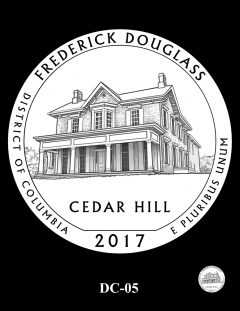 |
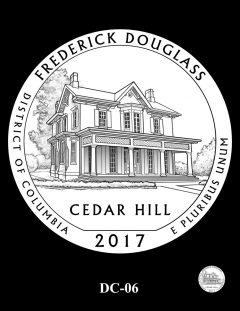 |
DC-05 and DC-06 feature two views of Cedar Hill, Frederick Douglass’s home in Washington, D.C.
Ozark National Scenic Riverways Site (Missouri)
CCAC Recommendations: Members preferred design #2.
CFA Recommendations: The Commission supported design #4, citing the use of trees to frame the scene of the historic mill and stream in conveying the setting of the Ozarks.
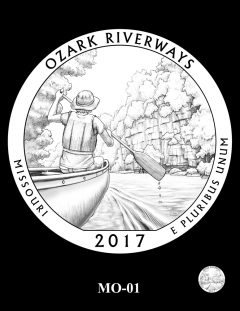 |
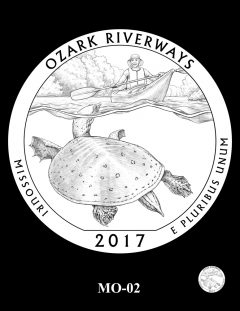 |
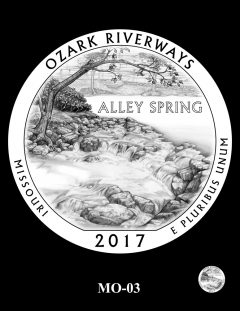 |
|
MO-01 depicts a canoeist paddling down a river, with cliffs towering above the water on one side. The park attracts visitors with its variety of recreational opportunities, including canoeing, swimming, and fishing.
MO-02 (the CCAC choice) features a Spiny Softshell turtle peering above the water, looking at a kayaker passing by.
MO-03 depicts the overflow falls of Alley Spring near the Alley Mill. This spring is located at the foot of a picturesque limestone bluff.
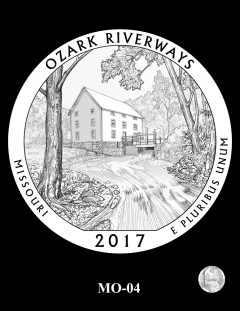 |
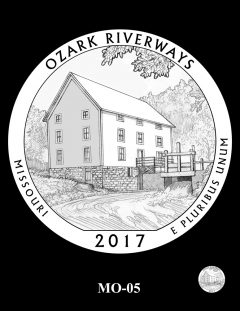 |
MO-04 (the CFA choice) and MO-05 depict Alley Mill, a steel roller mill built in 1894. This merchant mill was used to convert wheat into flour. Much of the original milling equipment is still in place and visitors to the park can tour the mill.
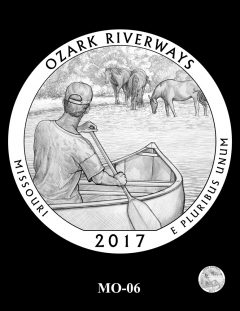 |
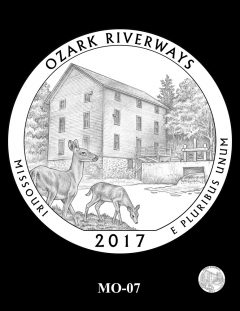 |
MO-06 depicts a man canoeing down a river and coming upon a group of wild horses drinking by the river’s edge.
MO-07 features a white-tailed deer and fawn near the river’s edge, with Alley Mill in the background.
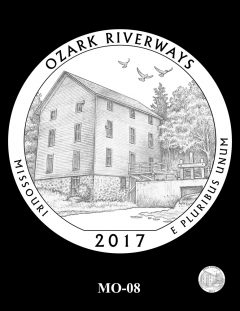 |
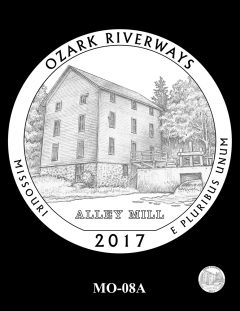 |
MO-08 and MO-08A depict Alley Mill.
Ellis Island National Monument (New Jersey)
CCAC Recommendations: Members did not select any of the designs, asking for more or re-workings.
CFA Recommendations: The members of the Commission recommended design #1, commenting that it best illustrates the history and setting of Ellis Island by including an immigrant family and a view of the water of New York harbor.
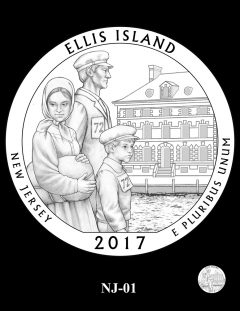 |
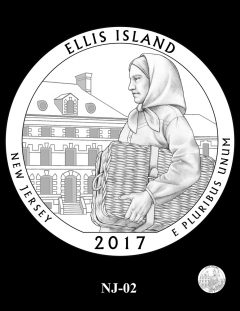 |
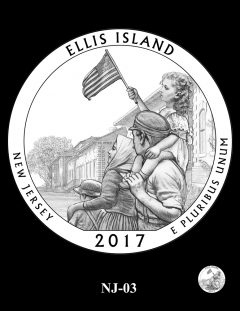 |
|
NJ-01 (the CFA choice) shows an immigrant family approaching Ellis Island with the Hospital Building in the background. The man looks forward with determination, a representation of Ellis Island as the "Island of Hope." The woman looks back, concerned that Ellis Island is also the "Island of Tears," where families were separated and individuals were denied entry into the country. The child represents the future growth and prosperity of the United States due to immigration.
NJ-02 depicts an immigrant woman approaching Ellis Island with the Hospital Building in the background.
NJ-03 features an immigrant family waiting on Ellis Island, hoping to be granted entry into the United States.
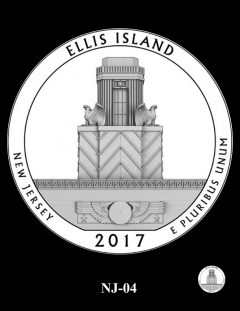 |
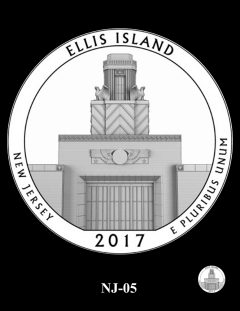 |
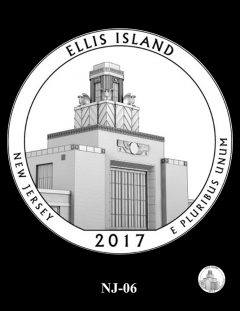 |
|
NJ-04, NJ-05, and NJ-06 feature views of the Ellis Island Ferry Building and its Art Deco spire. The ferry terminal has been referred to as "the happiest place on the island" because those who made it this far had successfully passed legal and health inspections and would now be permitted to start their new life in the United States.
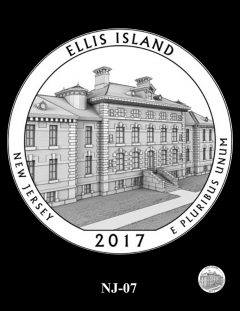 |
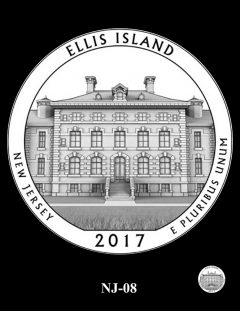 |
NJ-07 and NJ-08 depict the Ellis Island Immigrant Hospital. The hospital was the first — and one of the largest — public health hospitals in the United States. Immigrants who did not pass the health inspection on arrival to Ellis Island were sent to the hospital and detained until they recovered or were deemed too sick to enter the United States and sent back to their home countries. Nine out of ten patients were cured and allowed to enter the United States.
George Rogers Clark National Historical Park (Indiana)
CCAC Recommendations: Members preferred design #10.
CFA Recommendations: The Commission recommended design #5 for its strong composition and evocation of the harsh weather and conditions endured by Clark and his troops in his 1779 capture of Vincennes during the Revolutionary War.
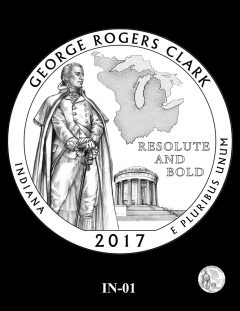 |
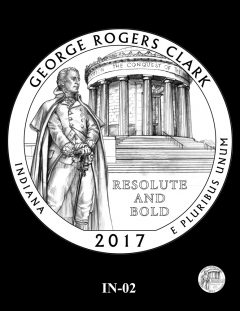 |
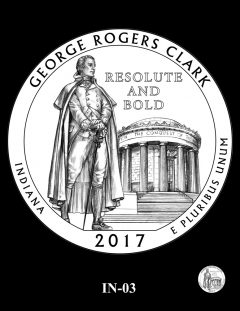 |
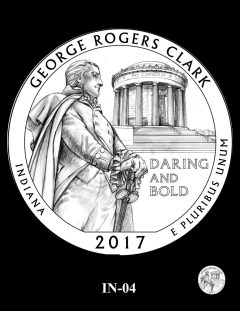 |
IN-01, IN-02, IN-03, and IN-04 feature the George Rogers Clark statue with the Memorial in the background. Design IN-01 also includes a depiction of the Northwest Territory Clark was credited with winning during the American Revolution. Additional inscriptions include "Resolute and Bold" and "Daring and Bold."
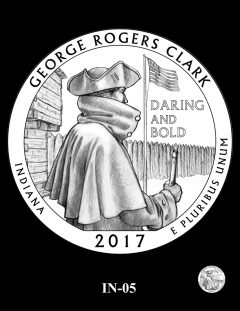
IN-05 (the CFA choice) depicts American Colonel George Rogers Clark standing outside the surrendered Fort Sackville where an American flag flies above. It includes the inscription "Daring and Bold." The surrender of Fort Sackville, which Clark secured in February 1779 after his army marched through freezing flood waters, assured United States claims to the frontier, an area nearly as large as the original 13 states.
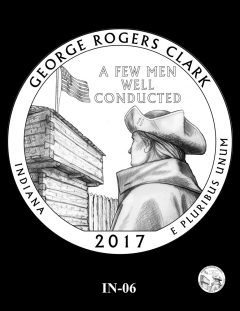 |
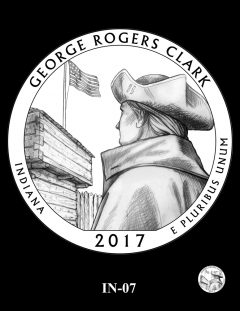 |
IN-06 and IN-07 depict George Rogers Clark staring up at the flag outside the surrendered Fort Sackville. In design IN-06, the additional inscription reads "A Few Men Well Conducted," a phrase taken from Clark’s letter to Virginia Governor Patrick Henry.
 |
 |
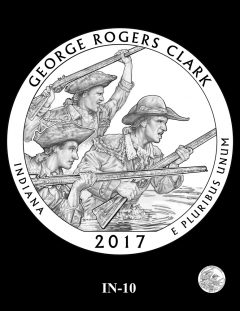 |
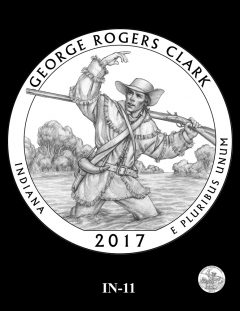 |
IN-08 depicts George Rogers Clark standing in front of Fort Sackville.
IN-09 depicts George Rogers Clark with the interior of Fort Sackville in the background.
IN-10 (the CCAC choice) features George Rogers Clark leading his men through the flooded plains approaching Fort Sackville.
IN-11 depicts George Rogers Clark on the march to Fort Sackville as he gestures to his men to follow.
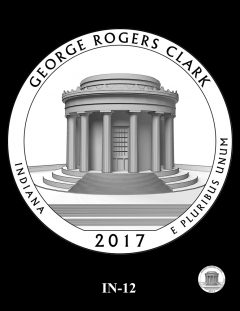 |
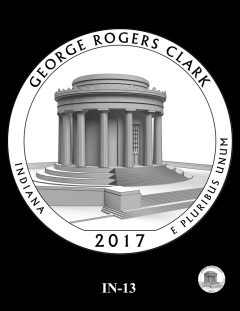 |
IN-12 and IN-13 feature the George Rogers Clark Memorial. Above the 16 Doric columns reads the inscription "The Conquest of the West George Rogers Clark and the Frontiersmen of the American Revolution." Inside the rotunda are seven murals and a bronze statue of Clark.

What…NO COMMENTS People?
How can that be?
Here are my 5 best design choices for each NP….
1A-08B
DC-01
MO-02
NJ-07
IN-02
I live in Vincennes, Indiana, and really do not care for the commission recommendations for The George Rogers Clark design. My choices would be any of the first 4 designs. Personally I feel that the Memorial should definately be part of the design. Any of the first 4, would make a beautiful, and very historical depiction. Design #1 or 2 would be my favorites.
For the New Jersey NJ01, almost but not quite there.
The wife should be expecting, husbands arm around her and his hand on son’s shoulder, flag in the boy’s hand.
“The promise of America for a new-comer family.”